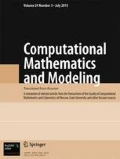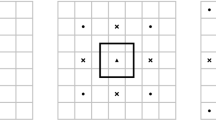We describe the possibilities of a numerical method based on quasi-gas dynamic (QGD) equations for the numerical simulation of a turbulent boundary layer. A subsonic Couette flow in nitrogen is used as an example, with dynamic Reynolds numbers of 153 and 198. The QGD system differs from the system of Navier–Stokes equations by additional nonlinear dissipative terms with a small parameter as a coefficient. In turbulent flow simulation, these terms describe small-scale effects that are not resolved on the grid. Comparison of our results (velocity profiles and mean-square velocity pulsations) with direct numerical simulation (DNS) results and benchmark experiments show that the QGD algorithm adequately describes the viscous and the logarithmic layers near the wall. Compared with high-accuracy DNS methods, the QGD algorithm permits using a relatively large spatial grid increment in the interior part of the viscous sublayer. Thus, the total number of grid points in the turbulent boundary layer may be relatively small. Unlike various versions of the large-eddy simulation (LES) method, the QGD algorithm does not require introduction of near-wall functions, because the additional terms vanish near the wall. For small Reynolds numbers, the QGD algorithm describes laminar Couette flow.
Similar content being viewed by others
References
H. Schlichting, Boundary-Layer Theory, McGraw-Hill, New York (1968).
M. Lesieur, Turbulence in Fluids, Springer (2008).
P. Sagaut, “Theoretical background: large-eddy simulation,” in: C. Wagner, T. Huttl, and P. Sagaut, editors, Large-Eddy Simulation for Acoustics, Cambridge University Press, Cambridge (2007), pp. 89–127.
S. Pirozzoli, M. Bernardini, and P. Orlandi, “Turbulence statistics in Couette flow at high Reynolds number,” J. Fluid Mech., 758, 327–343 (2014).
K. N. Volkov, “Formulation of wall boundary conditions in turbulent flow computations on unstructured meshes,” Comput. Math. Math. Phys., 54, No. 2, 353–367 (2014).
J. M. Robertson, “On turbulent plane Couette flow,” Proc. 6th Midwestern Conf. Fluid Mech., Univ. Texas, Austin (1959), pp. 169–182.
M. M. M. El Telbany and A. J. Reynolds, “Velocity distributions in plane turbulent channel flows,” J. Fluid Mech., 100 (part 1), 1–29 (1980).
J. A. Clark, “A study of incompressible turbulent boundary layers in channel flow,” J. Basic Engineering, 90, 455 (1968).
A. K. M. F. Hussain and W. C. Reynolds, “Measurements in fully developed turbulent channel flow,” J. Fluids Engineering, 97, 568–578 (1975).
M. M. M. El Telbany and A. J. Reynolds, “The structure of turbulent plane Couette flow,” J. Fluids Engineering, 104, 367–372 (1982).
B. L. Rozhdestvenskii, I. N. Simakin, and M. I. Stoinov, “Modeling turbulent Couette flow in a plane channel,” J. Appl. Mech. Tech. Phys., 30, No. 2, 223–229 (1989).
K. Bech, N. Tillmark, P. Alfredsson, and H. Andersson, “An investigation of turbulent plane Couette flow at low Reynolds numbers,” J. Fluid Mech., 286, 291–325 (1995).
O. Kitoh, K. Nakabyashi, and F. Nishimura, “Experimental study on mean velocity and turbulence characteristics of plane Couette flow: low-Reynolds-number effects and large longitudinal vortical structure,” J. Fluid Mech., 539, 199–227 (2005).
T. Tsukahara, H. Kawamura, and K. Shingai, “DNS of turbulent Couette flow with emphasis on the large-scale structure in the core region,” J. Turbulence, 7, No. 19 (2006).
P. A. Skovorodko, “Slip effects in compressible turbulent channel flow,” 28th International Symposium on Rarefied Gas Dynamics, 2012, AIP Conf. Proc. 1501 (2012), pp. 457–464.
V. Avsarkisov, S. Hoyas, M. Oberlack, and J. P. Garcia-Galache, “Turbulent plane Couette flow at moderately high Reynolds number,” J. Fluid Mech., 751, No. R1, (2014).
B. N. Chetverushkin, Kinetic Schemes and Quasi-Gas Dynamic System of Equations, CIMNE, Barcelona (2008).
Yu. V. Sheretov, Continuum Dynamics under Spatiotemporal Averaging. SPC Regular and Chaotic Dynamics [in Russian], Moscow-Izhevsk (2009).
T. G. Elizarova, Quasi-Gas Dynamic Equations, Springer, Dordrecht (2009).
M. V. Popov and T. G. Elizarova, “Smoothed MHD equations for numerical simulations of ideal quasi-neutral gas dynamic flows,” Computer Physics Communications, 196, No. 348–361 (2015).
I. A. Shirokov and T. G. Elizarova, “Simulation of laminar–turbulent transition in compressible Taylor–Green flow basing on quasigas dynamic equations,” J. Turbulence, 15, No. 10, 707–730 (2014).
V. G. Priimak, “Direct numerical simulation of spatially localized structures and wave motions in turbulent shear flows: Numerical requirements,” Mat. Model., 20, No. 12, 27–43 (2008).
G. A. Bird, Molecular Gas Dynamics and the Direct Simulation of Gas Flows, Clarendon Press, Oxford (1998).
H. W. Liepmann and A. Roshko, Elements of Gasdynamics, California Institute of Technology, John Willey and Sons, New York, 1957.
T. G. Elizarova and I. A. Shirokov, “Numerical simulation of a nonstationary flow in the vicinity of a hypersonic vehicle,” Math. Model. Comput. Simul., 4, No. 4, 410–418 (2012).
T. G. Elizarova and I. A. Shirokov, “Direct simulation of laminar-turbulent transition in a viscous compressible gas layer,” Comput. Math. Model., 25, No. 1, 27–48 (2012).
K-100 System, Keldysh Institute of Applied Mathematics RAS, Moscow; Available at http://www.kiam.ru/MVS/resourses/k100.htm.
J. Kim, P. Moin, and R. Moser, “Turbulence statistics in fully developed channel flow at low Reynolds number,” J. Fluid Mech., 177, 133–166 (1987).
J. Jeong and F. Hussain, “On the identification of a vortex,” J. Fluid Mech., 285, 69–94 (1995).
J. Fang, Y. Yao, Z. Li, and L. Lu, “Investigation of low-dissipation monotonicity-preserving scheme for direct numerical simulation of compressible turbulent flows,” Computers & Fluids, 104, 55–72 (2014).
T. G. Elizarova and P. N. Nikolskii, “Numerical simulation of the laminar–turbulent transition in the flow over a backward-facing step,” Vestn. MGU, Ser. 3: Fiz. Astron., No. 4, 14–17 (2007).
T. G. Elizarova, P. N. Nikolskii, and J. C. Lengrand, “A new variant of subgrid dissipation for LES method and simulation of laminar-turbulent transition in subsonic gas flows,” in: Shia-Hui Peng and Werner Haase, eds., Advances in Hybrid RANS-LES Modeling, Springer-Verlag, Berlin, (2008), pp. 289–298.
Author information
Authors and Affiliations
Corresponding author
Additional information
Translated from Prikladnaya Matematika i Informatika, No. 51, 2016, pp. 52–80.
Rights and permissions
About this article
Cite this article
Shirokov, I.A., Elizarova, T.G. Application of Quasi-Gas Dynamic Equations to Numerical Simulation of Near-Wall Turbulent Flows. Comput Math Model 28, 37–59 (2017). https://doi.org/10.1007/s10598-016-9344-z
Published:
Issue Date:
DOI: https://doi.org/10.1007/s10598-016-9344-z




